LIO
BachelorofArts(Honours)inInteriorArchitecture
ASSIGNMENT 1:
LEGISLATIVE AND REGULATIVE DIMENSION OF INTERIOR DESIGN
This project offered an in-depth exploration of the legal and regulatory framework governing the interior design profession. Collaborating with my peers, we investigated critical topics such as professional conduct, contractual obligations, and the legislative provisions outlined in the Architects Act 1967 and Uniform Building By-Laws1984.
Through this assignment, I gained a nuanced understanding of industry standards and the responsibilities of a professional interior designer. The hands-on process of synthesizing complex legal information into clear and concise presentations enhanced my analytical and communication skills. Moreover, the teamwork required for this project highlighted the importance of collaboration andknowledgesharinginprofessionalpractice.
Overall, this experience provided a solid foundation in the regulatory dimensions of the field, equipping me with the skills to apply these principles effectively in real-world scenarios. It has reinforced my commitment to ethical and informed design practice asIadvanceinmycareer.

ASSIGNMENT 2:
KNOWLEDGE EXCHANGE FORUM
This assignment provided an engaging platform for collaborative learning and professional development. Participating in weekly forums encouraged meaningful discussions with peers on topics such as fire safety and building regulations. It allowed me to critically analyze issues and share insights, fostering a deeper understandingofinteriorarchitecture'slegislativeaspects.
Additionally, the Professional Development Week seminars broadened my perspective on industry practices and trends. Summarizing these experiences in a structured format sharpened my reflective and organizational skills. Overall, this assignment enhanced my ability to communicate effectively, analyze professional topics critically, and apply learned concepts in realworldscenarios.
Taylor’s University
Bachelor of Arts (Honours) in Interior Architecture Professional Practice

knowledge exchange

T A B L E O F C O N T E N T S
INTRODUCTION OF ASSIGNMENT
SUMMARY FORUM 1

SUMMARY FORUM 2
SUMMARY FORUM 3
PDW SUMMARY
SEMINAR 1
SEMINAR 2
SEMINAR 3
SEMINAR 4
SEMINAR 5
SEMINAR 6
CONCLUSION


INTRODUCTION

This assignment focuses on enhancing my understanding of professional practice through two interconnected components: the Knowledge Exchange Forum and the Professional Development Week (PDW). Both tasks aim to develop my ability to engage in meaningful discussions with peers and reflect critically on industry practices, preparing me for the realities of working in interior architecture.
In the Knowledge Exchange Forum, I will explore the group theme, "Fire Safety in Buildings," which emphasizes the balance between ensuring occupant safety and maintaining creativity in design By participating in weekly forums and reflecting on the discussions, I hope to expand my knowledge of building regulations and understand how these impact architectural decision-making.
Additionally, the PDW offers an exciting opportunity to learn directly from professionals through seminars. By attending six sessions, I will gain insights into industry trends and reflect on how these learnings align with my academic and career goals. Together, these components will not only sharpen my critical thinking and communication skills but also provide a foundation for my growth as an interior architect.

FORUM1
TOPIC : Threats to the Interior Design profession
Abstract:

With the rise of unregistered firms offering architectural and interior design services through social media in Malaysia, professionals face growing challenges. These firms often undercut registered companies, utilizing unlicensed designers and architects, creating risks for clients and undermining industry standards. At the same time, rapid advancements in technology, including AI, are threatening to replace traditional roles in design.
How can the architectural and interior design professions navigate these twin threats—illegal practices and automation— while ensuring they remain relevant, innovative, and in demand? What strategies can be employed to maintain professional integrity, embrace technology, and ensure sustainable growth in a shifting landscape? Discuss.

Some articles/videos to look up before the forum starts:
https://www.bernama.com/en/news.php?id=2325910
https://themalaysianreserve.com/2024/08/23/lamunregistered-firms-offering-architectural-interiordesign-services-soar/
https://www.linkedin.com/pulse/future-interiorarchitecture-new-world-design-ai-jerry-george/
DURING-FORUM 1 CONVERSATIONS

Summary of Forum Exercise

The Forum 1 discussion explored the critical topic "Threats to the Interior Design Profession," focusing on two primary challenges: the growing number of unregistered firms offering architectural and design services and the impact of technological advancements like AI on traditional design roles. The dialogue emphasized the need for maintaining professional standards, embracing innovation, and enhancing client trust.


ConsumerAwareness ConsumerAwareness andTrust-Building andTrust-Building
Clients can mitigate risks by relying on trusted reviews and referrals to validate a designer’s credentials.
Transparent communication and showcasing quality work can enhance trust, helping clients distinguish between registered and unregistered professionals.
Adaptingto Adaptingto Technological Technological Advancements Advancements
Technological tools, including AI, offer opportunities for innovation but also pose a threat to traditional roles
Registered professionals must integrate advanced tools into their processes to remain competitive and enhance client satisfaction while upholding creativity
The Value of The Value of Registered Registered Professionals: Professionals:
Registered professionals provide long-term value by ensuring regulatory compliance, safety, and costeffective designs Their work reduces maintenance costs, enhances functionality, and protects clients from future legal or structural issues
THREATS TO THE INTERIOR DESIGN PROFESSION
Sustaining Sustaining ProfessionalIntegrity ProfessionalIntegrity
Strengthening regulations to address illegal practices is critical to maintaining industry standards
Interior architects and designers must remain proactive in adapting to challenges, balancing innovation with ethical practices to ensure sustainable growth.

FORUM2
TOPIC : Local Authority
Abstract:
A Completion and Compliance Certificate (CCC) is an essential legal document issued by the local authorities in Malaysia. It signifies that a building project has been completed according to approved plans and complies with Malaysian building codes, regulations, and safety standards. In Malaysia, it is mandatory to obtain a CCC before a property can be legally occupied. CCC confirms that a building is safe for occupation, emphasizing public safety. It also highlights the complexities and diligence involved in the application process, underlining the importance of transparency, adherence to regulations, and cooperation between developers and local authorities to ensure that structures meet the highest standards of safety and compliance.
These processes are often time-consuming, requiring significant administrative work and adherence to strict guidelines. In many cases, project timelines are short, placing additional pressure on architects and developers to meet the requirements within limited timeframes. This situation makes it difficult for professionals to focus on creating high-quality designs, as a large portion of their efforts are devoted to navigating these submission processes.
Some articles/videos to look up before the forum starts: https://www.linkedin.com/pulse/simple-guide-obtainingkm-bp-ccc-development-projects-amirul-hakim/ https://www.propertyguru.com.my/propertyguides/certificate-of-completion-compliance-ccc-15904 https://www.youtube.com/watch?v=jgJ0tL0Abf0




invalidate existing CCCs, requiring updated submissions and collaboration with PSPs for re-approval. The exercise underlines the need for multidisciplinary coordination, adherence to legal guidelines, and effectively advising clients through the regulatory process.

Certificate of Completion and Compliance (CCC)
Role of Interior Designers
While interior designers cannot directly submit the Building Plan (BP) or CCC (the responsibility of the Principal Submitting Person, PSP), they play an essential role in ensuring their designs align with approved plans and meet compliance standards.
For renovations that deviate from the original plans, interior designers must work closely with architects and engineers to obtain new approvals
Renovations and CCC Validity:
Any changes to the original approved plans invalidate the CCC The client must resubmit updated plans to the local authorities, involving a PSP to maintain compliance.
Interior designers guide clients by explaining the submission process and collaborating with the PSP to ensure a smooth re-approval process
IDLE Exam and CCC Knowledge
The inclusion of CCC-related questions in the IDLE exam emphasizes the need for interior designers to balance aesthetics with legal and safety compliance. This reflects the interdisciplinary nature of interior design and the importance of understanding local laws and statutory requirements
Challenges with CCC Processes
The CCC process involves significant administrative effort and strict guidelines, often requiring close collaboration between designers, developers, and PSPs Managing timelines and ensuring compliance adds complexity to projects, particularly for designers focused on both creative and regulatory aspects.



FORUM3
TOPIC : UBBL guidelines on fire safety in buildings.

Abstract:
The Uniform Building By-Law (UBBL) 1984 is essential for fire safety in Malaysia, combining passive and active systems to protect lives and property. However, as buildings become more complex and innovative, the guidelines need updates to address modern challenges. Suggestions include adopting smart fire technologies, performance-based designs, and encouraging creative solutions that maintain safety without limiting design.
Fire safety is crucial not just for architects but also for interior designers. Interior choices like materials, layout, and furnishings can affect fire risks, evacuation, and safety. Designers must understand fire requirements to create safe and beautiful spaces.
Insights from the videos emphasize the need for all design professionals to prioritize fire safety while fostering innovation.

Some articles/videos to look up before the forum starts:
https://youtu.be/wxKqvaL84Yk?si=8K1uXqwhDRUjTaYa
https://youtu.be/WohRbl3ZV78?si=ZWjvVEK0IBzbrGEr
DURING-FORUM 3 CONVERSATIONS







The exercise focuses on compliance with the Malaysia Uniform Building By-Law (UBBL) 1984 for fire safety in buildings. The aim is to explore how UBBL can address emerging challenges, balance safety with architectural innovation, and emphasize the importance of fire safety knowledge for interior designers in addition to architects.
Balancing aesthetics and safety Material Selection:
Fire-resistant materials
Compliance with Codes
NFPA standards
Egress routes and suppression systems
Awareness & Training
Fire drills
Signage and training sessions
UBBL Fire Safety in Building Design
Egress & Escape
Routes
Pathway clearance
Exit signage visibility
High-Risk Environments
Ventilation and flameresistant designs
Challenges & Recommendations
Modernizing UBBL to include advancements in materials and technologies
Fostering collaboration between designers and fire safety professionals
PROFESSIONAL DEVELOPMENT WEEK (PDW)
FINANCIAL LITERACY FOR FRESH GRADUATES
SPEAKER- AIA
EFFECTIVE NETWORKING THROUGHLINKEDIN: TIPS AND TRICKS"
SPEAKER: SHELL
THE MAKINGS OF A PROFESSIONAL ARCHITECT"
SPEAKER: 5FT2 STUDIO ARCHITECTS
CHALLENGES AND OPPORTUNITIES IN THE DESIGN INDUSTRY”
SPEAKER: CULT CREATIVE
APPRECIATING NEURODIVERSITY AT WORK"
SPEAKER: SLB (SCHLUMBERGER)
FROM CONCEPT TO MARKET: NAVIGATING PRODUCT COMMERCIALIZATION AND INTELLECTUAL PROPERTY FOR FOOD INNOVATORS"
SPEAKER: KNOWLEDGE TRANSFER & COMMERCIALIZATION
Date: 11th November 2024
Time: 10 00 AM - 11 00 AM
Topic: “Financial Literacy for Fresh Graduates" Speaker- AIA
SHORT NOTE
The seminar on Financial Literacy for Fresh Graduates by AIA focused on understanding spending habits, saving effectively, and planning finances Key concepts like cash flow, savings ratios, and emergency funds were discussed. Youth financial challenges were highlighted, and the AIA Apex Program was introduced to help participants practice financial management through simulations


SUMMARY

The seminar on Financial Literacy for Fresh Graduates by AIA emphasized the importance of understanding spending habits, building savings, and planning finances effectively. Key financial concepts were introduced, such as tracking cash flow, maintaining a savings ratio of at least 10%, and having 3–6 months of emergency funds. Participants reflected on their current spending behaviors and how these habits might change after starting a job. The session also highlighted common financial challenges among young people, such as low savings and rising debt, stressing the importance of early financial planning To help participants practice managing money and making informed decisions, AIA introduced the Apex Program, a two-week immersive simulation of 15 years of financial life. The program also offers career exploration and skillbuilding activities, preparing participants for real-world challenges
PURPOSE
1 Learn to manage finances and build smart spending habits after graduatioN
KEY POINTS DISCUSSED 2
Spending Habits: Participants identified if they save or spend first.
Financial Ratios: Tips to manage money: Save 10% of income
Have 3–6 months of savings for emergencies.
Track monthly cash flow (income vs. expenses).
Think about how you’ll use your first salary and why. Balance spending on needs, family, and personal goals.
Date: 12th November 2024
Time: 10.00 AM - 11.00 AM
Topic: "Effective Networking throughLinkedIn: Tips and Tricks"
Speaker: SHELL
SHORT NOTE
The LinkedIn networking session taught creating a strong profile, connecting with professionals, and sharing achievements to boost career opportunities. Akila emphasized active engagement and showcasing skills to attract jobs and mentors.


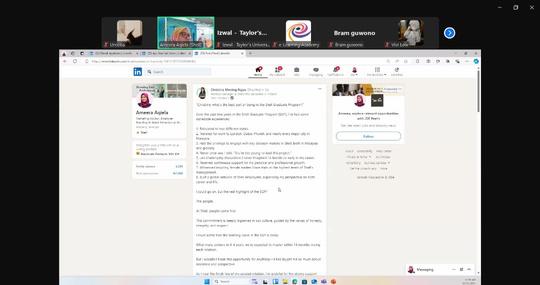
SUMMARY
The seminar, Effective Networking through LinkedIn, by Akila focused on using LinkedIn to build a personal brand, expand networks, and attract job opportunities. Key tips included creating a strong profile, posting reflections, connecting strategically, and showcasing achievements Participants learned how to use LinkedIn for mentorship, referrals, and professional visibility.
STRONG PROFILE
1
NETWORKING
5
4
Professional photo and headline.
Highlight skills and achievements.
2
CAREER GROWTH
Attract jobs, mentors, and referrals.
Engage with company updates.
TIPS
Reflect using STAR method (Situation, Task, Action, Result).
Highlight transferable skills.
3
Connect strategically. Use personalized messages.
SHOWCASE ACHIEVEMENTS
Post reflections and experiences. Add certifications and awards.
Date: 12th November 2024
Time: 11 30 AM - 12 30 AM
Topic: "The Makings of a Professional Architect"
Speaker: 5FT2 STUDIO ARCHITECTS
SHORT NOTE
The seminar explored an architect’s journey through various countries, balancing career and family while adapting to new challenges. It stressed the importance of problem-solving, client-focused design, and integrating modern tools to improve architectural practices. The speaker inspired young architects to keep learning and stay resilient in pursuing their passion
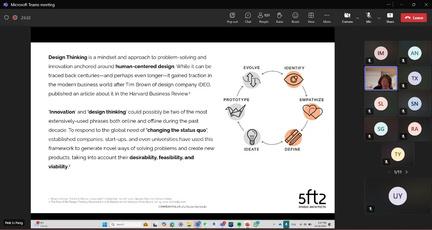
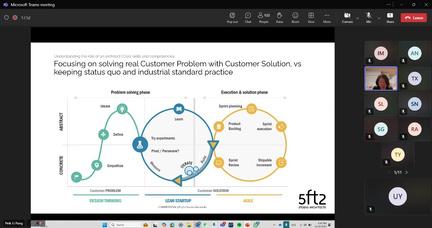
SUMMARY
The seminar "The Makings of a Professional Architect" by 5FT2 Studio Architects highlighted the speaker’s global journey and challenges as an architect. They emphasized perseverance, balancing family and career, and adapting to new environments. Key points included solving real-world problems, designing for clients’ needs, and using technology like AI to modernize architecture The speaker encouraged aspiring architects to stay open-minded, embrace learning, and overcome setbacks to make meaningful contributions to the industry.
JOURNEY
THE MAKINGS OF A PROFESSIONAL ARCHITECT
KEY CHALLENGES
1
5
4
Worked in the Netherlands, US, Malaysia
Balanced family and career
Restarted career multiple times
ADVICE FOR US
Embrace real-world challenges
Combine creativity with practicality
Overcome setbacks with perseverance
CONCLUS ION
Perseverance and adaptability
Focus on solving real-world
Embrace technology
Take small, impactful steps
2
Adapting to new cultures and climates
Balancing family and work
Licensing and financial constraints
3
SUCCESS TIPS
Stay persistent and passionate
Focus on solving client problems
Use modern tools like AI
Continuously learn and adapt
Date: 14th November 2024
Time: 11 30 AM - 12 30 AM
Topic: “Challenges and Opportunities in the Design Industry” Speaker: CULT CREATIVE
SHORT NOTE
The seminar, "Challenges and Opportunities in the Design Industry," by Miss Lina Isa, co-founder and CMO of Cult Creative, focused on the evolving creative industry She shared her journey and emphasized the importance of adaptability, creativity, and soft skills for success. The talk highlighted opportunities for roles like graphic designers and content creators while addressing challenges such as limited networks, the impact of AI, and funding issues. Miss Lina encouraged students to build strong portfolios, stay updated with trends, and take calculated risks to thrive in the competitive industry


SUMMARY
Miss Lina Isa discussed the global growth of the creative industry and the rising demand for various creative roles. She highlighted that adaptability and personality often matter more than technical skills in creative careers Challenges like AI’s role, market saturation, and limited funding were addressed. She encouraged networking, resilience, and taking risks to stand out Cult Creative’s platform was introduced as a way for creatives to connect with brands, earn, and develop skills. The talk provided students with practical advice to navigate and succeed in this dynamic field
CHALLENGES AND OPPORTUNITIES IN THE DESIGN INDUSTRY
OPPORTUNITIES
Growing global creative market
In-demand roles: Graphic Designers, Content Creators, Copywriters
Creativity and adaptability valued
CHALLENGES
Limited networking access
AI as a threat and tool
Funding and societal stigma
Market saturation
CAREERTIPS
Build a unique portfolio
Stay updated with trends
Develop technical and soft skills
Collaborate and network
Manage time efficiently
CULT CREATIVE
Job platform for creatives
New tools for brand deals and content
creators
STUDENT ADVICE
Focus on resilience and adaptability
Take risks and embrace learning
Avoid comparing career paths
Use networking to grow
Date: 14th November 2024
Time: 11 30 AM - 12 30 AM
Topic:“Challenges and Opportunities in the Design Industry” Speaker: CULT CREATIVE
SHORT NOTE
Neurodiversity values different cognitive strengths like ADHD and autism. SLB promotes inclusion by offering tailored hiring, workplace support, and training. This boosts innovation and creates opportunities for neurodivergent employees Though Malaysia lags in awareness, SLB drives change with impactful programs.
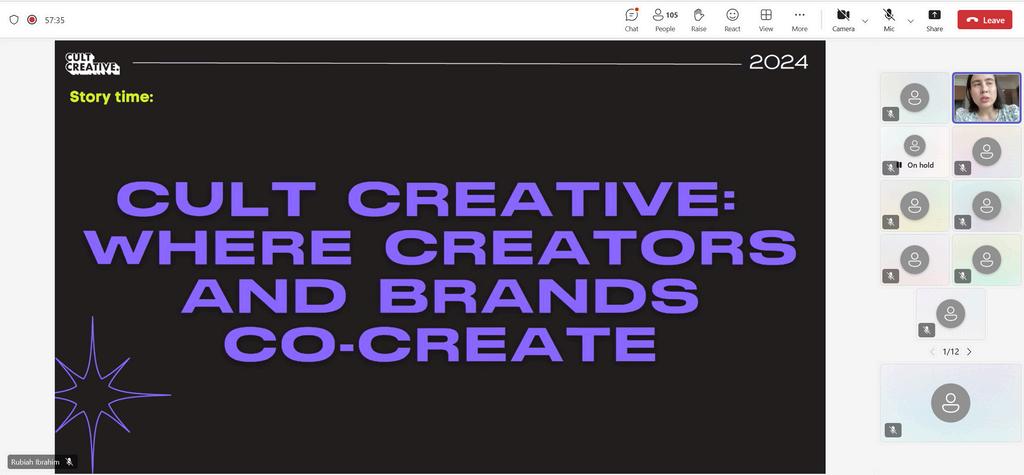
SUMMARY
The seminar focused on understanding and supporting neurodiversity in the workplace, highlighting the inclusion of individuals with different cognitive abilities, such as ADHD, autism, and dyslexia SLB shared its efforts to create an inclusive environment through skill-based hiring, tailored support like quiet rooms, and job coaching The company emphasized how embracing neurodiversity increases innovation, productivity, and empathy in leadership. While Malaysia faces challenges with awareness and employment, SLB is leading initiatives to promote inclusivity and provide meaningful opportunities for neurodivergent talent.
NEURODIVERSITY AT WORK
WHAT IS NEURODIVERSITY?
SLB’S CULTURE OF INCLUSION
SUPPORT FOR NEURODIVERGENT EMPLOYEES
BENEFITS OF NEURODIVERSITY
CHALLENGES IN MALAYSIA
FUTURE GOALS
Inclusion of diverse cognitive profiles. Neurotypical vs. Neurodivergent (e.g., ADHD, autism).
Celebrating differences for innovation.
People, Technology, and Performance.
Diversity: Gender, ethnicity, age, cognitive functioning.
Inclusion: Psychological safety, respect, and value.
Tailored recruiting processes (skill-based). Onboarding adjustments (clear instructions, job coaches).
Workplace accommodations (quiet rooms, noisecanceling headsets).
Boosts innovation and productivity. Enhances leadership empathy. Improves organizational reputation.
80% of neurodivergent workforce underemployed. Cultural barriers and lack of formal statistics. Growing efforts by non-profits and corporations.
Spread awareness.
Build inclusive workplace cultures.
Create meaningful career opportunities.
Date: 15th November 2024
Time: 04 00 AM - 05 00 PM
Topic:"From Concept to Market: Navigating Product Commercialization and Intellectual Property for Food Innovators"
Speaker: KNOWLEDGE TRANSFER & COMMERCIALIZATION
SHORT NOTE
The seminar, "From Concept to Market," by Ms. Natasha Tajudin, covered the journey of food innovation from development to commercialization, emphasizing the importance of intellectual property (IP) Key topics included distinguishing invention from innovation, exploring trends like alternative proteins, and navigating the commercialization process Students were encouraged to consider careers in food R&D, academia, or entrepreneurship while leveraging IP to secure a competitive edge in the industry.
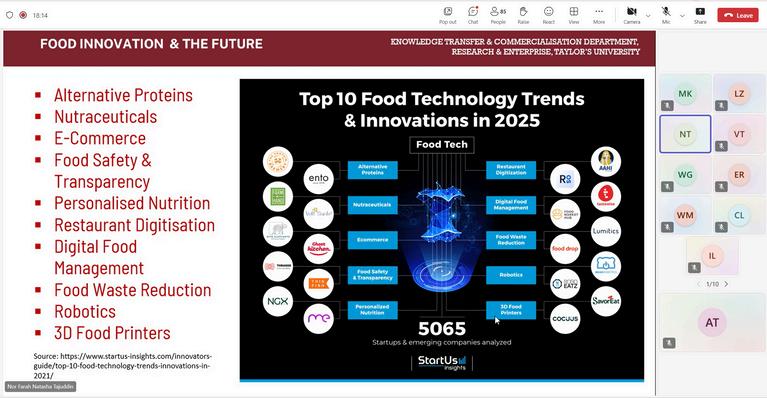
SUMMARY

The seminar, "From Concept to Market," by Ms. Nor Far Natasha Tajudin, explored the journey of food innovation from development to commercialization, emphasizing intellectual property (IP) protection Key topics included distinguishing invention from innovation, food industry trends like alternative proteins and personalized nutrition, and the commercialization process, including market validation and go-to-market strategies. Ms. Natasha encouraged students to explore careers in R&D, academia, and entrepreneurship while leveraging IP to secure a competitive edge in the evolving food industry
FROM CONCEPT TO MARKET
INTRODUCTION
CORECONCEPTS
Speaker: Ms. Nor Far Natasha Tajudin
Subject: Commercializing food innovations and intellectual property (IP)
Audience: Food Science and Culinary Arts
students
Invention vs. Innovation
Invention: Novel solutions, not necessarily marketready
Innovation: Practical, value-creating application
Importance of commercial viability
KEY FOOD INDUSTRY TRENDS
ROLE OF INTELLECTUAL PROPERTY
Alternative proteins (plant-based foods, cultured meat)
Personalized nutrition (customized dietary solutions)
E-commerce and digital food management
Sustainability and food waste reduction
Food safety and transparency (blockchain, smart labels)
Secures competitive advantage
Protects and monetizes innovations
Facilitates partnerships and licensing opportunities
KEY LESSONS
Innovation drives industry impact and growth. IP is essential for protecting and monetizing ideas. Collaboration is key in the commercialization journey.
Conclusion

This assignment provided a valuable opportunity for personal growth and learning through various seminars and forums. The forums were particularly engaging, fostering open discussions and allowing me to explore diverse perspectives shared by my classmates. I gained insights into topics such as financial management, promoting neurodiversity in the workplace, and leveraging teamwork and collaboration to drive innovation.
The seminars offered practical knowledge on transforming ideas into market-ready products, safeguarding intellectual property, and keeping pace with industry trends. These sessions encouraged me to think critically and explore how these concepts could be applied in real-world scenarios.

In summary, the blend of forums and seminars bridged the gap between academic learning and real-world challenges. I acquired essential tools, skills, and motivation to grow both personally and professionally, equipping me for future career success.
ASSIGNMENT 3:
FUTURE PRACTICES (FORMATION OF IDCP)
Thisassignmentwasanexcitingopportunitytoenvisionanddevelop a future design practice. By integrating knowledge from previous projects, I collaborated with my team to create a comprehensive business model that adhered to professional standards and addressedcontemporarychallengesinthedesignindustry.
The process of forming a hypothetical design company, including defining its vision, mission, organizational structure, and financial planning, allowed me to apply theoretical knowledge to practical scenarios. It also highlighted the importance of adaptability and innovation in shaping a business that can thrive in a dynamic environment.
Overall, this project deepened my understanding of the intricacies involved in setting up a design practice and prepared me for the professionalresponsibilitiesofthefield.Itwasavaluableexperience thatcombinedcreativity,strategicplanning,andteamwork.

ASSIGNMENT 4:
FINAL PROJECT: BY-LAW APPLICATION AND PREREQUISITES FOR BUILDING PLAN SUBMISSION
This project was a valuable exercise in applying theoretical knowledge to a practical context. It required me to integrate the regulatory, legislative, and technical aspects of building design into a comprehensive report for AIAD2. By addressing compliance with UBBL and MS1184 standards, I gained a deeper understanding of essential concepts such as fire safety, disabled accessibility, and sustainabledesign.
The process of identifying non-compliance areas and proposing rectifications honed my problem-solving skills and attention to detail. Preparing the technical drawings and documentation further improved my ability to communicate complex ideas clearly and effectively. Overall, this assignment reinforced the importance of adhering to legal and technical standards in professional practice and equipped me with critical skills for future projects. It was a challenging yet rewarding experience that enhanced both my technical expertise andprofessionalconfidence.

